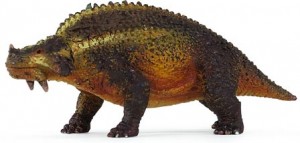The Remarkable Scutosaurus – a Brilliant Light Bulb
The Remarkable Scutosaurus – Permian Giant
The Permian period lasted from 290 million years to 248 million years ago. A major event during this part of the Palaeozoic was the formation of the super-continent of Pangaea. Shifting continental plates had begun to create a single, huge landmass in Carboniferous times, but it was in the Permian that the supercontinent Pangea formed. Pangaea was to last for over a 100 million years before beginning to break up in the Early Jurassic. As the continental plates that make up the Earth’s crust are still moving today, the break up is continuing. For example, the Atlantic ocean is getting a little wider each year, roughly at the same speed your finger nails grow.
The end of the Permian is marked by a mass extinction event, approximately 65% of all vertebrate families became extinct. Amongst the casualties were the bizarre armoured Pareiasaurs, a group of strange looking reptiles, some of which grew to the size of cars.
Scutosaurus
One of the more advanced pareiasaurs was the enormous Scutosaurus. At something like 3 metres long and weighing as much as 1,000 kilogrammes this animal was one of the largest land living animals to have ever existed when they roamed the dry, arid landscapes of the Permian supercontinent.
Scutosaurus had a squat body, strong, powerful legs, and a short tail that was too small to reach the ground. The broad head had a large mouth and the animal was probably an unfussy grazer of coarse, plant material. The large body supported a huge gut, a prerequisite if you are going to try to digest tough plant matter.
Thickened Skull
The skull was thickened and ornamented with bizarre knobs and bumps. Ornamentations on the skull are a common feature of pareiasaurs, some smaller forms even evolved head shields, making them resemble horned dinosaurs such as Triceratops and Styracosaurus.
Scutosaurus was a very advanced Permian reptile, the legs of this animal did not sprawl out to the side like other reptiles. Instead they were directly under the body, supporting the animal’s great weight. This stance and gait made Scutosaurus a very efficient walker and these animals may have migrated long distances in search of food to fill their enormous stomachs.
When the fossil record is examined, the pareiasaurs seem to have evolved and diversified very quickly towards the end of the Permian, perhaps exploiting the environmental niches left vacant as other genera died out. Scientists have estimated that there may have been dozens of different genera. Then, as quickly as they appear in the fossil record, they all disappear, it seems that no pareiasaurs survived into the Mesozoic. Some palaeontologists refer to ancient reptiles like Scutosaurus as fossil record light bulbs – they shine very brightly, but briefly in the fossil record, before like a light bulb, burning out and disappearing forever.
A Scale Model of Scutosaurus
Picture credit: Everything Dinosaur
To view the huge range of prehistoric animal models and figures available from Everything Dinosaur: Dinosaur and Prehistoric Animal Models.


